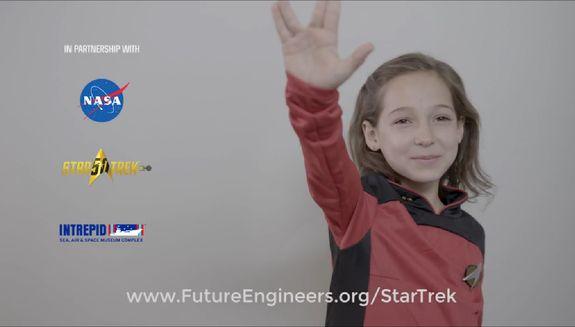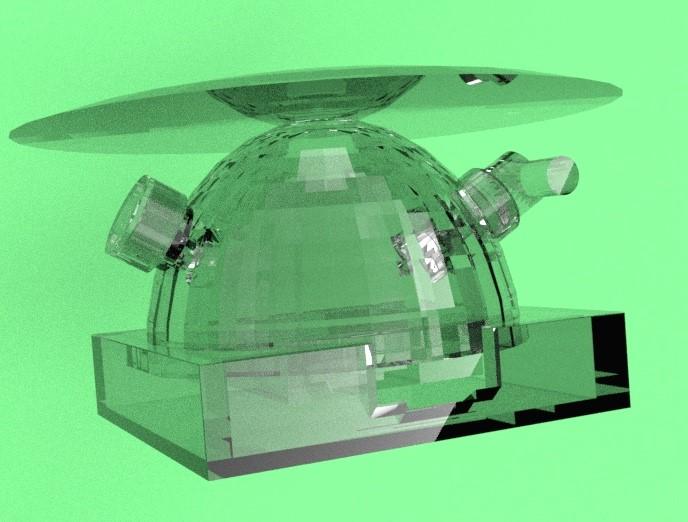 There are some things that never get old, and Star Trek seems to be one of them. The original series aired back in the 1960s, but multiple spinoffs, a reboot, and a super-loyal, generation-spanning fan base have kept the franchise very much alive and at the forefront of our pop culture. In fact, people who were just kids when Star Trek was born are now seeing their grandchildren not only becoming fans, but using the series as a springboard for their own scientific exploration.
There are some things that never get old, and Star Trek seems to be one of them. The original series aired back in the 1960s, but multiple spinoffs, a reboot, and a super-loyal, generation-spanning fan base have kept the franchise very much alive and at the forefront of our pop culture. In fact, people who were just kids when Star Trek was born are now seeing their grandchildren not only becoming fans, but using the series as a springboard for their own scientific exploration.
Earlier this year, the Star Trek franchise along with MakerBot, NASA and Future Engineers issued a challenge to students from kindergarten to twelfth grade: design 3D printable inventions that could be used by future astronauts to make nutritious food in space. The Future Engineers 3-D Printing Star Trek Replicator Challenge (named for MakerBot’s Replicator series of printers as well as the meal-producing device from the original Star Trek) asked kids to consider what astronauts may be using for nutrition in 2050, and the kids responded with ingenuity that would put many adults to shame.
The contest was first announced in February, and today a panel of judges from NASA, the American Society of Mechanical Engineers (ASME) Foundation and Made In Space, Inc. announced the winners. 405 submissions were received from kids in 30 states, so it had to be tough to select a winner, but in the end it came down to Kyle Corrette in the Teen (ages 13-19) Group and Sreyash Sola in the Junior (ages 5-12) Group.
Corrette, a student at Desert Vista High School in Phoenix, Arizona, won in the Teen category with his Melanized Fungarium device. Melanized fungi are fungi that get their energy from radioactivity, which is plentiful in space, so Corrette’s theory is that the fungi could be cultivated as a renewable food source. His design is comprised of a 3D printed, waterproof plastic shell that encloses an organic growth bed and an irrigation system. To cultivate the fungus, water is pumped through an extruding intake tube through an internal piping network into the growth bed. The device was specially crafted to be used within a microgravity environment.
Junior Group winner Sola, a student at Eagle Ridge Middle School in Ashburn, Virginia, designed an Astro Mini Farm for the production of food on Mars. While there are many obstacles to growing food on Mars, one of the obvious ones is the lack of sunlight – Mars is further away from the sun than Earth, so it’s naturally going to be less sunny. Sola’s Mini Farm is a 3D printed domelike structure with a magnifying glass that directs sunlight to the plants, which are cultivated inside of the dome. A hole provides access for water and soil. A pump can also be added to pressurize the container, since the atmosphere on Mars is much thinner than that on Earth.
In addition to Corrette and Sola, three finalists were named in each category:
Teen Group:
- Ansel Austin for the Spirulina Farm
- Thomas Salverson for his Multi-Purpose Mug
- Navya Annapareddy for CosmoAquaponics
Junior Group:
- Emily Takara for her Bioreactor Ornament
- Tobias Platt for his Water Condenser
- Owen DuFrene for the E-Z Blender
The winners and finalists will each receive a MakerBot Replicator Mini Compact 3D Printer for their school and a PancakeBot pancake printer for home. Sola and Corrette will also travel to New York City to meet former NASA astronaut Mike Massimino, see the Space Shuttle Enterprise at the Intrepid Sea, Air, & Space Museum, and tour MakerBot’s headquarters. All of the winning and finalist 3D models are available for download from their project pages.
The Replicator challenge was the third in a series of Future Engineers 3D printing challenges for students, co-sponsored by the ASME Foundation and NASA as part of the White House Nation of Makers initiative. Previous competitions included the 3D Space Container Challege in 2015 and the 3D Space Tool Challenge in 2014. There’s also still a little under a month left to enter the Think Outside the Box Challenge, which you can learn more about here. Discuss further over in the 3D Printing Challenge Winners forum over at 3DPB.com.
Subscribe to Our Email Newsletter
Stay up-to-date on all the latest news from the 3D printing industry and receive information and offers from third party vendors.
You May Also Like
Air Force Awards Fortius Metals $1.25M to Qualify 3D Printing Wire for Hypersonic Applications
AFWERX, part of the US Air Force Research Laboratory (AFRL), awarded a Direct-to-Phase II Small Business Innovation Research (SBIR) contract worth $1.25 million to Colorado’s Fortius Metals, to accelerate qualification...
US Air Force Awards JuggerBot $4M for Large-format Hybrid 3D Printing
Large-format 3D printer manufacturer JuggerBot has received a $4 million grant to develop a large format 3D printer, courtesy of the Under Secretary of Defense, Research and Engineering Manufacturing Technology...
Where Have All AM’s Unicorns Gone?
In the rapidly evolving world of 3D printing, startups valued at over a billion dollars, known as unicorns, once seemed as fantastical as the mythical creatures themselves. While a few...
How My Childhood Fascination with Planes Led to Investing in 3D Printing
My fascination with aerospace started young, and I started studying planes–identifying them in the sky and learning everything I could about how they work. Fast forward to my first week...


































